TVs are not just getting bigger, brighter, and better looking, they’re also getting smarter. The latest generation of TVs now have AI features that work to improve picture and sound quality as well as offer unique experiences on screen as you watch. If you’re considering buying a new TV for your home or business, here’s a rundown of the latest TV technology and some highlights from the top brands.
What Do All Those TV Acronyms Mean?
Before diving into the AI features and specific models, let’s look at the various TV technologies. There are two main TV types: LED and OLED. You’ll see other acronyms as well, which are generally ones used by specific manufacturers to differentiate their offerings. Here’s a guide to help you understand.
The Different TV Types
LED: These are a type of LCD TV (liquid crystal display) that use backlights or light-emitting diodes (LEDs) via small bulbs to produce a vibrant and bright image. You can find affordable LED TVs in all sizes.
Mini-LEDs: One of the latest variations on LED TVs are mini-LED TVs, which use even smaller LED chips for better control over local dimming. The result is said to be improved contrast, deeper blacks, and an overall better picture.
OLED: Organic light emitting diodes are used with these types of TVs such that every pixel on the screen emits light, so you don’t require a backlight. The result is deeper, richer blacks, crisper whites, better contrast, more vibrant colours, wider viewing angles, and an overall better picture. Not surprisingly, OLED TVs tend to be the most expensive of the bunch.
QLED: Most notably found in Samsung TVs, QLED is a more advanced version of LCD/LED technology. Like conventional LED TVs, they have backlights that transmit the image through the screen. QLED adds a thin layer called a quantum dot filter between the backlights and the screen to ensure purer, more vivid, overall better pictures and colours.
QNED: This is LG’s own display technology that combines both quantum dots, as noted above, with NanoCell technology. The NanoCell technology is designed to filter and refine colours, which purportedly affords even greater purity and accuracy. QNED TVs that have mini-LED backlighting promise to offer better contrast and brightness compared to conventional LED TVs.
ULED: Developed by Hisense, ULED TVs are yet another variation on LED TVs that combines local dimming, wide colour gamut, and 4K resolution. They have technology designed to combat things like motion blur and ghosting. Many also reportedly use quantum dot technology. The benefit is that they are an affordable alternative for customers on a budget.
Highlights From the Top Brands for 2025
Every major TV brand has a new line of TVs coming in 2025, some models of which might already be available. If you’re shopping around, here are some key things to note about each of them.
Samsung is Centered on Vision AI
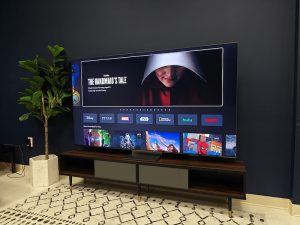
Samsung QLED
Samsung’s 2025 line includes both OLED and QLED models, the latter of which come in 8K variations as well. Pricing ranges from as little as $1,600 up to $20,000 for a massive 115-incher. There’s also the new The Frame Pro TV, a design-conscious TV with a stylish bezel that can display artwork when it’s not in use on the matte screen. (Samsung’s Art Store is now accessible on the full line of TVs as well). The new Neo QLED 4K line uses Quantum Matrix Mini LEDs, a more powerful processor, and features like Supersize Picture Enhancer to prevent blur (top-line model). The new OLED TVs, meanwhile, include features like improved OLED Glare-free technology.
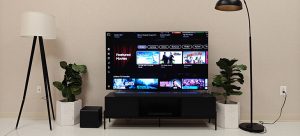
Samsung OLED
Most notably, Samsung’s new TV line incorporates Samsung Vision AI, affording access to tons of cool AI-powered features. With Click to Search, you can call up a right-side panel on the screen that will give you more details about the actors on screen along with recommendations of what to watch next. It works with live TV services via a push of the button on the remote, but the feature sadly isn’t coming to Canada. There’s also Generative Wallpaper, which allows you to use a series of prompts to create a soothing wallpaper image for the TV. With a compatible Samsung Galaxy smartwatch like the Galaxy Watch Ultra, you can use gestures to control the TV, your hand effectively becoming the on-screen pointer. The new TV line will come with Copilot built-in as well so you can get help doing everything from booking a family vacation to finding a good brunch spot or learning about a subject for homework, right from the big screen.
LG’s webOS is Getting Smarter, More Intuitive

LG QNED
LG’s new TV line will, like other brands, be powered by AI with tons of goodies. The new OLED evo line boasts a faster, AI-powered processor, Brightness Booster Ultimate, AI-enhanced picture and sound processing, and support for Filmmaker Mode with Ambient Light Compensation. The more affordable QNED Evo line is being expanded as well, with a focus not just on improved picture quality but also a better, more intuitive, smarter webOS smart TV experience via an updated interface. The showstopper remains the 77-inch Signature OLED T, which can sit in the middle of a living room on a custom stand and transform from transparent to opaque. It’s finally available in the U.S. years after being announced, but there’s no word yet on Canada.
The new TVs will come with Copilot built in and a new AI Remote with features like AI Search by voice, a Generative Image Gallery, and more. Use the dedicated AI button on the remote and short-press for relevant keywords and TV features or long-press to conduct a personalized search using large language models (LLMs).
The new TVs are also part of LG’s Re:New Program that assures five years of webOS upgrades, so you’ll get all the latest features for many years to come.
Hisense Has Unique Laser TV Options
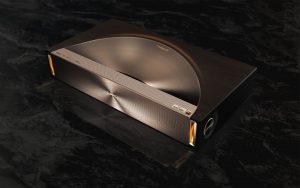
Hisense L9Q
Hisense has a wide range of TVs coming in 2025, including mini-LED QLED TVs, the 116-inch TriChroma LED TV, which uses red, green, and blue LEDs independently to generate purer colours, and the L9Q TriChroma laser TV, a unique alternative to the standard TV. It’s sort of a mix of a flat-screen TV and a projector, able to project an image as large as 150 inches onto the special Ambient Light Rejection (ALR) screen that comes with it. With up to 5,000 lumens brightness and 5,000:1 contrast, it’s suuitable for the living room, not just the dark basement.
Hisense also has its CanvasTV line, the brand’s answer to Samsung’s The Frame. Available in larger 75-inch and 85-inch sizes starting this July (it’s already available in 55- and 65-inch sizes), they hang seamlessly on the wall using the near zero gap mount and can display artwork in Art Mode, as well as personal photos.
TCL Vows to Eliminate the Halo Effect
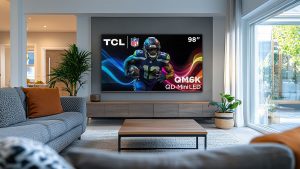
TCL QM6K
The latest TVs from TCL coming to Canada include the new QM6K and QM7K Series, which were shown at CES earlier this year and are available for pre-order now. The hallmark of these TVs is more advanced colour and light processing through TCL’s own Halo Control System. This system, says the company, ensures better colour and grey scale accuracy without any blooming, which is when a bright object on screen bleeds light into a darker area, essentially creating a halo-like effect in the picture.
Using QD-Mini LED screens that TCL has designed and built, and available in sizes from 55 inches up to 115 inches, the QM6K line is the more affordable option and the QM7K the higher-end option with features like HDR support and Bang & Olufsen audio.
Sony Takes the Guesswork Out of AI
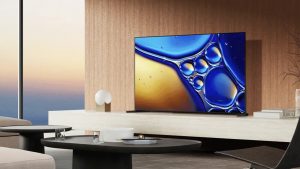 Sony’s 2025 Bravia line will include even bigger models and include a new OLED TV as well as a Mini-LED TV. The Bravia 8 II is the new flagship QD-OLED TV, and it includes, along with Sony’s XR processor, an AI scene recognition system. This can intelligently detect what type of content you are watching, like sports, an action movie, or the local news, and adjust the screen for you. AI upscaling technology also ensures that you get more detail even when watching lower-resolution content. You’ll also find Sony’s Acoustic Surface Audio+ feature, which creates sound from various places around the TV, not just a dedicated spot for a more immersive experience, even without external speakers.
Sony’s 2025 Bravia line will include even bigger models and include a new OLED TV as well as a Mini-LED TV. The Bravia 8 II is the new flagship QD-OLED TV, and it includes, along with Sony’s XR processor, an AI scene recognition system. This can intelligently detect what type of content you are watching, like sports, an action movie, or the local news, and adjust the screen for you. AI upscaling technology also ensures that you get more detail even when watching lower-resolution content. You’ll also find Sony’s Acoustic Surface Audio+ feature, which creates sound from various places around the TV, not just a dedicated spot for a more immersive experience, even without external speakers.
The Bravia 5, meanwhile, is the new OLED TV model which will be similar in feature set to last year’s model but will come in at a more affordable price. Available in screen sizes up to 98 inches, it’s joined by the Bravia 2 II, designed for the more budget conscious customer.
Choosing the Right TV
The TV landscape is bursting with new options. Whether you want to upgrade your living room or basement set-up with a new big screen before the summer or in time for holiday events or you’re looking for a smaller TV for the bedroom, den, or even up at the cottage, you’re spoiled for choice.
Choose the right specs and TV type: Find a brand and model that has the specifications you want and is of the type you prefer. If you watch a lot of movies or beautifully shot TV shows, consider opting for an OLED. It will cost more but you’ll get the best picture that money can buy. For daily family viewing of sitcoms, local news, animated movies, and more, any variant of LED TV will suffice. Select a premium model so you get vibrant colours, deep blacks, crisp whites, great contrast, and favourable viewing angles so everyone in the family gets to sit in the sweet spot.
Pay attention to the smart TV interface and menu navigation: Consider the AI and smart features as well. It should be easy to navigate menus and find what you want without struggling. All the latest TVs are smart TVs, but they operate on different platforms. Some come with Google TV or Android TV (available with brands like Sony, Hisense, and TCL), while Samsung TVs are built on the Tizen OS and LG with webOS.
Go big or go home: Go bigger than you think you’ll want and spend a few extra bucks for a TV from a reputable brand with impressive specs. Don’t just go for how they look in store: read reviews from reputable sources to learn how they’ll actually look in your home when watching the type of content you watch and in more realistic lighting conditions. Oftentimes, shoppers will go home with buyer’s remorse that they didn’t spend the extra few hundred dollars for the next size or model tier up. Save more than your initial budget, even if it means having to wait a few more months to invest. If you absolutely need to stick with your tight budget, keep an eye out for sales, which come often from the top retailers and e-tailers. You will likely be able to find a better TV for less.
-30-



